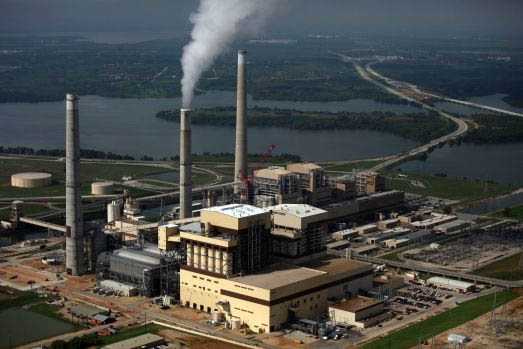JULY 31, 2015
Karen Hadden
San Antonio Express-News

CPS Energy’s coal plants Spruce 2, left, Spruce 1, center, and Deely are seen on Calaveras Lake. The utility has moved toward cleaner energy production and is well prepared to deal with federal clean air rules. Photo By LISA KRANTZ /SAN ANTONIO EXPRESS-NEWS
CPS Energy is well positioned to meet the goals of EPA’s new Clean Power Plan, a rule designed to reduce global warming pollution from power plants. San Antonio will come out a winner due to CPS Energy’s foresight in developing renewable energy, such as solar and wind, and the increased use of energy efficiency to reduce the amount of electricity needed.
Several years ago, CPS Energy was under pressure from SEED Coalition, Neighborhoods First Alliance, Jefferson Heights Neighborhood Association and others to retire the old and polluting Deely coal plants. The settlement reached in the Spruce 2 coal plant case, local citizen activism, and the leadership of Mayors Julián Castro and Phil Hardberger, CPS Energy’s Doyle Beneby, and Solar San Antonio have all helped put the utility on a clean energy path, positioned well to exceed the EPA’s new global warming requirements.
CPS Energy keeps electric rates among the lowest in the nation’s largest U.S. cities. The utility ranks first in the state and seventh in the nation for solar generation, and is building out 400 MW of solar. Solar leasing and community solar programs are being piloted to help more people and businesses benefit directly from solar investment. CPS Energy’s plan has led to new businesses locating their headquarters in San Antonio. Over 700 new jobs have been created, with an annual payroll of nearly $40 million. New factories have been built to manufacture solar panels, inverters and highly efficient lighting, all of which will be needed by other utilities seeking to comply with the new carbon pollution rules.
Twelve states have larger carbon reduction goals than Texas, which is required to reduce carbon emissions from coal plants by 39 percent. San Antonio will retire Deely 1 & 2 by 2018, and we will have cleaner air to breathe as a result.
Our state continues to lead the nation in wind production, and solar investment is on the increase since costs are plummeting. Texas can meet its goals and can benefit financially from the Clean Power Plan if we further develop renewable energy and arrange for other states to buy renewable energy credits from us.
Texas will likely reach the renewable energy goal required by the rule, 20 percent by 2030, a couple years early. Using more efficient appliances and equipment will help meet Texas’ carbon reductions, along with demand side reduction, shifting the time of use of electricity to off-peak hours.
While some utilities complain of the costs that the rule would create, what we really can’t afford is the cost of inaction. Climate change impacts are being seen already, in intensified storms, temperature extremes, drought and flooding.
According to a report called Come Heat and High Water, Texas climate impacts will be most evident in the number of days of extreme heat each year. The typical Texan has experienced an average of 43 days per year of temperatures above 95°F, but there will likely be up to 106 days per year by 2040-2059. Texas will lead the nation in heat related deaths, with an additional 2,570 lives lost each year. Ranching and farming will be impacted. For example, corn yields will likely decrease. The sea level at Galveston will likely rise 1.5 to 2.0 feet by 2050 and $20.9 billion in Texas coastal property is likely to be flooded at high tide by 2030.
The cost of inaction will be higher than the cost of action to reduce global warming impacts, in terms of dollars and human lives. CPS Energy has shown that achieving much-needed carbon reductions through renewable energy and energy efficiency is doable and affordable, demonstrating to other utilities how Clean Power Plan goals can readily be met.
Karen Hadden is executive director of the Sustainable Energy & Economic Development (SEED) Coalition, which works for clean air and clean energy in Texas, in coordination with local organizations.
This document contains copyrighted material whose use has not been specifically authorized by the copyright owner. SEED Coalition is making this article available in our efforts to advance understanding of ecological sustainability, human rights, economic democracy and social justice issues. We believe that this constitutes a "fair use" of the copyrighted material as provided for in section 107 of the US Copyright Law. If you wish to use this copyrighted material for purposes of your own that go beyond "fair use", you must obtain permission from the copyright owner.